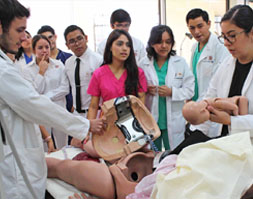Regularities of the teaching-learning process of Public Health subject in medical studies
Keywords:
ENSEÑANZA, APRENDIZAJE, SALUD PÚBLICA, EDUCACIÓN SUPERIOR.Abstract
Introduction: Public Health subject is aimed at contributing to the training of practitioners and their ways of performance for them to learn the epidemiological method in order to modify the process of health-disease for the benefit of population.
Objective: to identify the main regularities of the teaching-learning process of Public Health subject in the Medical Studies at Pinar del Río University of Medical Sciences.
Method: a study was carried out based on the dialectical materialistic method, as well as the use of theoretical and statistical methods to capture the trends in the development of the teaching-learning process of this subject.
Results: the difficulties are identified in the groundwork of the subject according to the aim of the profession, along with insufficiencies in the appropriation and integration by the students to the main scientific concepts of the subject, which limits the assimilation of the epidemiological thought which is inherent with respect to the training of the general physician.
Conclusions: it was possible to identify as regularities the orientation to the integration of the syllabus as a whole and articulate the subject of Public Health to the link of the design of teaching-learning process, where weaknesses were found to integrate the contents into the subject.
Downloads
References
1-Salas Perea RS, Salas Mainegra A. Modelo formativo del médico cubano. Bases teóricas y metodológicas. La Habana: Editorial Ciencias Médicas; Cuba 2017. http://www.bvs.sld.cu/libros_texto/modelo_formativo_medico_cubano/indice_p.htm
2-Viciedo Tomey A. La integración de conocimientos en la educación médica. Educ Med Super [Internet]. 2009 Dic [citado 2017 mayo 15]; 23( 4 ):[Aprox.11p.] . Disponible en: http://scielo.sld.cu/scielo.php?script=sci_arttext&pid=S0864-21412009000400008&lng=es.
3-Vela Valdés J, Fernández Sacasas J. Las asignaturas de salud pública en las políticas de formación para la carrera de medicina. Rev Cubana Salud Pública [Internet]. 2012 Sep [citado 2017 mayo 15]; 38 (3):[Aprox.9p]. Disponible en: http://scielo.sld.cu/scielo.php?script=sci_arttext&pid=S0864-34662012000300005&lng=es.
4- Álvarez Sintes R, Hernández Cabrera G, Báster Moro Juan C, García Núñez R C. Medicina General Integral. Tomo I. Parte II. Capitulo 3;2015. pag.29. http://bvs.sld.cu/libros_texto/mgi_tomo1_3raedicion/cap3.pdf
5-Álvarez de Zayas CM. La Escuela de la vida. (Didáctica) Octava Edición Año; 2011. Disponible en: http://www.conectadel.org/wp-content/uploads/downloads/2013/03/La_escuela_en_la_vida_C_Alvarez.pdf
6-Borrell RM. “La educación médica en América Latina: debates centrales sobre los paradigmas científicos y epistemológicos”. Facultad de Ciencias Médicas. Universidad Nacional de Rosario. UNR Editora. Argentina; 2005. Disponible en: https://cursos.campusvirtualsp.org/pluginfile.php/86391/mod_resource/content/0/Modulo_I/Capitulo_EM_para_libro_de_Rosario.pdf
7- Vela Valdés J, Salas Perea RS, Pujals Victoria N, Quintana Calende ML, Pérez Hoz G. Planes de estudio de Medicina en Cuba de 1959 a 2010. Educ Med Super [Internet]. 2016 Mar [citado 2017 mayo 15]; 30 (1). Disponible en: http://scielo.sld.cu/scielo.php?script=sci_arttext&pid=S0864-21412016000100002&lng=es.
8-Martínez Calvo S. Calidad del proceso de enseñanza del análisis de situación de salud en la carrera de medicina. Escuela Nacional de Salud Pública. Revista Habanera de Ciencias Médicas [internet] 2012[citado 2017 oct 24] ;12(2):[Aprox.9p.]. Disponible en: http://scielo.sld.cu/pdf/rhcm/v12n2/rhcm11213.pdf
9- Toledo Curbelo JG, Rodríguez Hernández P, Reyes Sigarreta M, Cruz Acosta A, Caraballoso Hernández M, Sánchez Santos L, et al. Fundamentos de Salud Pública: Editorial Ciencia Médicas; 2008. Disponible en: http://bvs.sld.cu/libros_texto/salud_publica_1/indice_p.htm
10-Diccionario de filosofía. Editorial Progreso. Moscú, URSS; 1984. Disponible en: http://www.filosofia.org/urss/ddf1984.htm
11-Garrido Tapia EJ, Manso López AM, Morales González M, Escalona Fernández LA, Aprendizaje en la asignatura Salud Pública a través de mapas conceptuales. ccm [Internet]. 2016 Sep [citado 2017 mayo 15]; 20( 3 ):[Aprox.9p.]. Disponible en: http://scielo.sld.cu/scielo.php?script=sci_arttext&pid=S1560-43812016000300010&lng=es.
12-Chaos Correa Valdés de la Rosa C, Estrada Rodriguez J, Llanes Rodriguez A. Sistema de tareas docentes para desarrollar habilidades profesionales desde la asignatura MGI en 5to año de medicina. AMC [Internet]. 2015 Ago [citado 2017 mayo 15]; 19(4): [Aprox.13p.]. Disponible en: http://scielo.sld.cu/scielo.php?script=sci_arttext&pid=S1025-02552015000400013&lng=es.
13-Martínez Calvo S. Renovación del Análisis de Situación de Salud en los servicios de medicina familiar en Cuba. Revista Cubana de Salud Pública [internet]. 2013 [citado 2017 oct 24];39(4):[Aprox.10p.] Disponible en: http://scielo.sld.cu/pdf/rcsp/v39n4/spu11413.pdf
14-Talízina N, Psicología de la enseñanza Editorial Progreso. Moscú URSS; 1988.

Published
How to Cite
Issue
Section
License
Authors who have publications with this journal agree to the following terms: Authors will retain their copyrights and grant the journal the right of first publication of their work, which will be publication of their work, which will be simultaneously subject to the Creative Commons Attribution License (CC-BY-NC 4.0) that allows third parties to share the work as long as its author and first publication in this journal are indicated.
Authors may adopt other non-exclusive license agreements for distribution of the published version of the work (e.g.: deposit it in an institutional telematic archive or publish it in a volume). Likewise, and according to the recommendations of the Medical Sciences Editorial (ECIMED), authors must declare in each article their contribution according to the CRediT taxonomy (contributor roles). This taxonomy includes 14 roles, which can be used to represent the tasks typically performed by contributors in scientific academic production. It should be consulted in monograph) whenever initial publication in this journal is indicated. Authors are allowed and encouraged to disseminate their work through the Internet (e.g., in institutional telematic archives or on their web page) before and during the submission process, which may produce interesting exchanges and increase citations of the published work. (See The effect of open access). https://casrai.org/credit/


